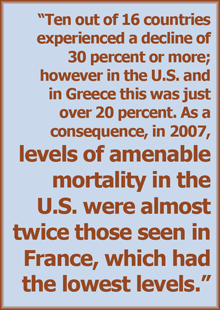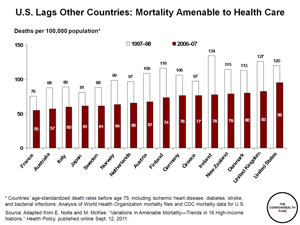Synopsis
The rate of "mortality amenable to health care" — that is, deaths that are considered preventable with timely and effective health care — declined for people under age 75 across 16 high-income nations between 1997–1998 and 2006–2007. While all countries showed improvement, the United States improved the least.
Background
The concept of "amenable mortality" refers to unnecessary and untimely premature deaths from certain causes that are potentially preventable with timely and effective health care. Amenable mortality is one of many indicators used to measure health system performance across nations. This Commonwealth Fund–supported study examined trends in amenable mortality for people under age 75 in 16 high-income countries between 1997–1998 and 2006–2007.

Key Findings
- In 2006–2007, amenable mortality accounted for 24 percent of deaths under age 75 in the 16 countries studied.
- Rates were lowest in France, with 55.0 deaths per 100,000 people, followed by Australia (56.9 per 100,000) and Italy (59.9 per 100,000). The highest levels were in the United States, with 95.5 deaths per 100,000 people, followed by the United Kingdom (82.5 per 100,000) and Denmark (80.1 per 100,000).
- Between 1997–1998 and 2006–2007, levels of amenable mortality fell by 30 percent or more in 10 of the 16 countries; however, the rate in the U.S. fell by only 20.5 percent, the lowest level of decline. Ireland had the highest rate of decline (42.1%).
- If the U.S. had achieved levels of amenable mortality seen in the three best-performing countries — France, Australia, and Italy — 84,300 fewer people under age 75 would have died in 2006–2007.

Addressing the Problem
Although amenable mortality fell consistently in all countries, the scale and pace of improvement varied. The United States' poor performance and relatively slow improvement compared with other nations may be attributable to "the lack of universal coverage and high costs of care," the authors conclude.
About the Study
The authors use data from the World Health Organization's mortality database for the periods 1997–1998 through 2006–2007. The countries included in the study are: Australia, Austria, Denmark, Finland, France, Germany, Greece, Ireland, Italy, Japan, Netherlands, New Zealand, Norway, Sweden, the United Kingdom, and the United States. The causes of death considered amenable to health care include selected childhood infections, treatable cancers, diabetes, cerebrovascular disease and hypertension, and complications of common surgical procedures. The authors also included ischemic heart disease, but only considered 50 percent of such deaths as amenable to health care. The upper age limit was set at 75.
The Bottom Line
If the U.S. had achieved levels of amenable mortality seen in the three best-performing countries—France, Australia, and Italy—84,300 fewer people under age 75 would have died in 2006–2007.